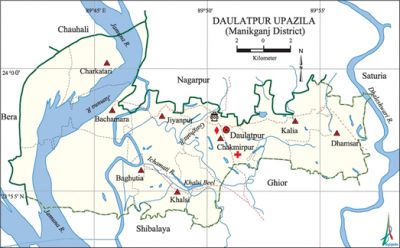Daulatpur Upazila (Manikganj District)
Daulatpur Upazila (manikganj district|) area 218.34 sq km, located in between 23°54' and 24°02' north latitudes and in between 89°41' and 89°57' east longitudes. It is bounded by chauhali and nagarpur upazilas on the north, shivalaya and ghior upazilas on the south, saturia upazila on the east, bera upazila and jamuna river on the west.
Population Total 167026; male 80489, female 86537; Muslim 158275, Hindu 8708, Christian 29 and others 14.
Water bodies Main rivers: Jamuna, dhaleshwari and ichamati; Gaighata canal and Khalsi beel are notable.
Administration Daulatpur Thana was formed in 1919 and it was turned into an upazila in 1983.'
| Upazila | ||||||||
| Municipality | Union | Mouza | Village | Population | Density (per sq km) | Literacy rate (%) | ||
| Urban | Rural | Urban | Rural | |||||
| - | 8 | 152 | 188 | 6918 | 160108 | 765 | 51.8 | 34.1 |
| Upazila Town | ||||||||
|
Area |
Mouza |
Population |
Density |
Literacy rate (%) | ||||
| 4.26 | 1 | 6918 | 1624 | 51.8 | ||||
| Union | ||||
| Name of union and GO code | Area (acre) | Population | Literacy rate (%) | |
| Male | Female | |||
| Kalia 76 | 5666 | 9833 | 10589 | 42.4 |
| Khalsi 85 | 5591 | 10208 | 11015 | 37.0 |
| Chakmirpur 28 | 6097 | 11896 | 12535 | 48.7 |
| Charkatari 38 | 4698 | 6970 | 7023 | 28.1 |
| Jiyanpur 66 | 4903 | 9578 | 10410 | 41.3 |
| Dhamsar 57 | 5760 | 9860 | 10615 | 34.2 |
| Baghutia 19 | 11586 | 9981 | 10745 | 26.5 |
| Bachamara 17 | 9652 | 12163 | 13605 | 17.5 |
Source Bangladesh Population Census 2011, Bangladesh Bureau of Statistics.

War of Liberation Freedom fighters of the upazila had encounters with Pak army at a number of places including Kakna, Nirali and Nilua. A number of Pakisyani soldiers had been killed in these encounters.
For details: see দৌলতপুর উপজেলা, বাংলাদেশ মুক্তিযুদ্ধ জ্ঞানকোষ (Encyclopedia of Bangladesh War of Liberation), বাংলাদেশ এশিয়াটিক সোসাইটি, ঢাকা ২০২০, খণ্ড ৫।
Religious institutions Mosque 206, temple 62, tomb 20. Noted religious institution: Dhamsar Tomb.
Literacy rate and educational institutions Average literacy 34.9%; male 40.4%, female 29.8%. Educational institutions: college 3, secondary school 21, primary school 158, madrasa 29. Noted educational institutions: Taluknagar College (1972), Daulatpur Matilal College (1972), Bachamara College (1972), Daulatpur Pilot High School (1949), Bachamara High School (1950), Kalia High School (1964), Baghutia High School (1964), Taluknagar High School (1965), Charkatari Sabuj Sena High School (1966), Charmastul High School (1969), Kakna High School (1967), Khalsi High School (1968).
Cultural organisations Club 23, theatre group 5, women's organisation 3.
'Main sources of income Agriculture 72.30%, non-agricultural labourer 3.42%, industry 0.77%, commerce 9.92%, transport and communication 1.53%, service 5.87%, construction 0.98%, religious service 0.16%, rent and remittance 0.40% and others 4.65%.
Ownership of agricultural land Landowner 72.08%, landless 27.92%; agricultural landowner: urban 35.11% and rural 73.58%.
Main crops Jute, mustard, peanut.
Extinct or nearly extinct crops Barley, linseed, kaun.
Main fruits Mango, jackfruit, papaya, banana, guava.
Fisheries, dairies and poultries Fishery 20.
Communication facilities Roads: pucca 19 km, semi-pucca road 3 km, mud road 50 km; waterways 25 km.
Extinct or nearly extinct traditional transport Palanquin, bullock cart, horse carriage.
Noted manufactories Rice and flour mill 106, oil mill 32, bidi factory 2.
Cottage industries Weaving, bamboo work, cane work.
Hats, bazars and fairs Hats and bazars are 23, fairs 10, most noted of which are Daulatpur, Ziyarapur, Kalia, Dhamsar, Bachamara and Charkatari hats.
Main exports Peanut.
Access to electricity All the unions of the upazila are under rural electrification net-work. However 32.9% of the dwellings have access to electricity.
Sources of drinking water Tube-well 94.0%, tap 0.2% and others 5.8%.
Sanitation 46.6% of dwelling households of the upazila use sanitary latrines and 50.1% of dwelling houses use non-sanitary latrines; 3.3% of households do not have latrine facilities.
Health centres Upazila health complex 1, union health centre 3, family planning centre 5, NGO operated health centre 1.
NGO activities asa, brac. [Manoranjan Mandal]
References Bangladesh Population Census 2001 and 2011, Bangladesh Bureau of Statistics; Cultural survey report of Daulatpur Upazila 2007.
